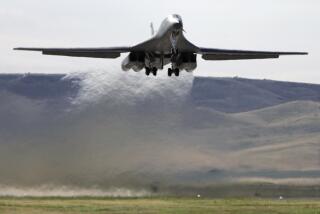FBI Ends Probe of TWA Flight 800 Crash
NEW YORK — The FBI officially ended its massive investigation Tuesday of the crash of TWA Flight 800, concluding that no evidence exists that a criminal act downed the jumbo jet in the Atlantic Ocean last year, killing all 230 people on board.
In an age of reflexive skepticism of government and suspected conspiracies fueled through the Internet, the FBI elected to make public extraordinary details of its 16 months of scrutiny.
The FBI said its work with the CIA, the Bureau of Alcohol, Tobacco and Firearms and other federal agencies systematically excluded the possibilities that a bomb, a missile or some other criminal act was responsible for the crash on July 17, 1996.
James K. Kallstrom, assistant FBI director in charge of the New York field office, told a press conference that “we ran out of things to do . . . . We looked under every rock 10 times.”
After piecing together much of the recovered fuselage in a hangar, “there was no evidence of high-explosive damage. There was no evidence of an explosion of a missile warhead. There was no evidence of missile impact,” Kallstrom said.
“Government agencies found nothing consistent with a bomb, missile or an explosive device,” he added.
Also central to the conclusion was the discovery that the explosion began in the central fuel tank of the plane and that all 244 eyewitnesses “saw events after the center fuel tank exploded,” Kallstrom said, eliminating the possibility that someone saw a missile hit the aircraft.
CIA weapons analysts said eyewitnesses who saw streaks in the sky glimpsed the Boeing 747 breaking up after the explosion. A CIA video simulation shown Tuesday re-created what people saw. CIA analysts concluded that, after the fuel tank exploded, the front third of the plane separated from the fuselage, causing the rest of the plane to climb from 13,000 feet to 17,000 feet and the sight of burning fuel during the ascent gave the illusion of a missile’s exhaust.
*
Kallstrom said that he spoke recently with Pierre Salinger, a former ABC-TV newsman and White House press secretary, and that Salinger was giving up his conspiracy claim that the plane was downed because of friendly fire.
Despite the examination of nearly 1 million pieces from the jetliner, what caused the vapor-filled center tank containing just a few gallons of jet fuel to blow up remains a mystery.
The National Transportation Safety Board will hold a week of public hearings in Baltimore on the crash in December and is conducting complicated testing--some of it highly experimental--to try to find the answer.
TWA Flight 800 sat on the tarmac at New York’s John F. Kennedy International Airport for 3 hours and 48 minutes before it lumbered off the runway at 8:19 p.m. bound for Paris. Its center fuel tank was largely empty because the aircraft carried a light load. At 8:31 p.m., the huge jet blew up.
FBI and White House officials suspected sabotage. More than 500 FBI agents quickly were thrown into the investigation.
On Tuesday, Kallstrom painstakingly delineated the probe for reporters, a day after family members of victims were briefed. His lecture could have come from a criminology textbook.
*
Agents almost immediately checked radio transmissions from TWA 800 and found them uneventful. Everyone who touched the aircraft while it was on the ground at Kennedy--ranging from cargo handlers to caterers to the outside contractor who provided in-flight motion pictures--was interviewed.
All cargo placed aboard the plane was identified. Radar tapes of the plane’s brief flight were studied and air traffic controllers on duty at several sites were questioned.
Roadblocks and checkpoints were set up on Long Island near the scene of the crash to identify potential witnesses and to ask people if they saw anything suspicious. All marinas in a three-state area were canvassed after weapons experts theorized the plane could have been downed by a missile fired from a boat.
Ships that traveled through New York’s harbor 12 hours before or after the crash were identified. FBI agents found 371 vessels in the Long Island area and investigated the boats.
They also scrutinized 20,000 records of vessels that entered New York’s harbor for a month, Kallstrom said. Every boat that was recorded passing under three drawbridges in Suffolk County on Long Island for three months before the crash and two weeks after it also received scrutiny.
FBI agents and police compiled all reports of stolen or abandoned boats within a three-state area. Forensic experts pored over some of the vessels that were recovered looking for burn marks indicating a missile firing.
Local police departments also provided the FBI with all 911 telephone calls or complaints of suspicious people, boats or cars in the vicinity of Kennedy Airport for two months before the crash.
“We looked at every one of those records,” Kallstrom said.
FBI investigators studied nine missile attacks on aircraft during a 14-year period in the Soviet Union, Afghanistan and Africa to identify launch sites, types of weapons and forensic evidence. They also studied previous airplane bombings.
Meanwhile, Navy and law enforcement divers were recovering pieces of the plane that were reassembled in a huge hangar in Calverton, N.Y. Suspicious parts were tested for explosives residue. In all, 39,600 items of personal effects were cataloged, boxed and examined.
FBI agents conducted 452 interviews in Athens where the flight originated and eventually questioned relatives of almost all the people who perished aboard the aircraft.
As 92 feet of the fuselage was being assembled in the hangar--the largest crash reconstruction in history--Kallstrom said the FBI summoned independent metallurgists to help check for signs of missile or bomb damage. None was found.
*
All seat cushions that were recovered underwent X-ray scrutiny. Bomb-sniffing dogs examined the wreckage, and on more than 2,000 occasions, pieces of the plane were checked chemically for signs of explosives.
Kallstrom said the FBI identified military operations within 200 nautical miles the night of the crash. All training exercises were documented and any weapons capable of reaching the plane were checked. The officers and crew of several ships were questioned and the vessels were inspected. FBI agents also questioned crew members aboard planes and helicopters in the area.
More than 7,000 interviews were conducted by the FBI during its 16-month investigation.
To help clarify information from 244 eyewitnesses, the FBI turned to the CIA for help. After careful analysis, Kallstrom said, that agency’s weapons experts decided what some people thought was a missile hitting the plane really was burning fuel as it leaked from the jet.
*
Researcher Lynette Ferdinand contributed to this story.
More to Read
Sign up for Essential California
The most important California stories and recommendations in your inbox every morning.
You may occasionally receive promotional content from the Los Angeles Times.










